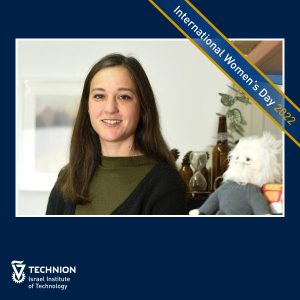Traveling Space & Time
Noa Zilberman, a Physics PhD student, interweaves her passion for general relativity with her love of poetry, nature hikes, and making science more accessible for the general public
Noa Zilberman, who is 28 and from Haifa, was always attracted to exploring the universe that surrounds her. “Ever since I can remember, I looked up at the sky in awe. The desire to grasp something from this universe, with its inconceivable dimensions and complexity, and to understand my place in it as a tiny speck floating on a speck that revolves around another speck – this is one of the forces that guides my life.”
Remembering her childhood, she says: “I was very shy and insecure. In class, I didn’t dare raise my hand, even if I knew the answer and nobody else raised their hand… But it was important for me to confront my fears. I would play the piano in school ceremonies even if my hands trembled, and I would recite texts even if I stuttered terribly. Today, I thank young Noa for choosing to grow from these challenges rather than giving in to them. In my military service I had the privilege of teaching high school students with learning difficulties. I tried to stir their sense of curiosity and passion to learn, and to make them feel capable. There is nothing more fulfilling than a girl telling me, eyes shining, that thanks to me, she now loves math, or a boy revealing that he completed his matriculation exams owing to the fact that I believed in him.”
In 2017, Noa finished her undergraduate studies in Physics and Mathematics with distinction, as part of the Physics Department Honors Program at the Technion. “Physics gave me a new lens through which to observe the world. And I simply fell in love with Math – it has an abstract beauty with which I was previously unfamiliar. During my undergraduate studies, I also experienced research for the first time, along with the huge privilege that comes with it: while in the lecture hall, we acquire the knowledge that has been accrued so far, something different and exciting happens during research – an opportunity to expand, if only by a little, the boundaries of human knowledge.”
After completing her B.Sc., Noa continued to a direct doctoral track in the Department of Physics under the supervision of Prof. Amos Ori. Her field of research is general relativity – the physical theory devised by Albert Einstein whereby gravity is embodied in the space-time curvature. “My research is very theoretical – the least applicable that I could find,” she laughs. Her doctoral thesis deals with semi-classical general relativity, which is the study of quantum fields on a classical (that is, non-quantum) curved spacetime background.
“We are studying the question of how quantum effects may modify the classical, well-known space-time picture in which the inner horizon of a black hole serves as a bridge to other universes. I realize this sounds like science fiction, but it is what the mathematics of general relativity tell us. Still, one must remember that general relativity is not a complete theory of nature, since it does not fit together with another successful theory, quantum physics. In most situations, one of the theories is sufficient to describe the physics, but it appears that a black hole is a special and extreme playground where the two theories play side by side. So, we are actually asking how the effects of the quantum vacuum will change the picture we obtained when we ignored the universe’s quantum nature. What do I mean by ‘quantum vacuum’? In a quantum reality, the vacuum is not an empty state that doesn’t contain anything. On the contrary – Heisenberg’s uncertainty principle tells us that a quantum field cannot ‘stay still.’ The vacuum state is teeming with fields that move and change all the time. Therefore, even in the absence of matter, the quantum effects related to the vacuum itself may dramatically change the space-time picture. Using analytic and numerical tools, we calculate the different expectation values that are essential for understanding the internal geometry of a black hole in the presence of a quantum vacuum.”
In addition to her demanding research work, Noa volunteers with the organization “Little Big Science,” an NGO aiming to make science more accessible for the general public. There, she writes, hosts panels and is a member of its scientific steering committee. She is also a member of the NGO “Robin Food” for the prevention of food waste, lectures at the Icon Festival for Science Fiction and Fantasy, and enjoys academic teaching as a teaching assistant for the course “Introduction to General Relativity.”
The rest of the time, you will probably find her wandering around the forest, foraging mushrooms, or waxing poetic about some insect. “In addition to research and writing articles, I try to spend a lot of time in nature, play the piano and take part in different types of athletic and creative activities.”
Besides academic writing and writing for laymen in “Little Big Science,” Noa also writes poetry. Her poems, which are unsurprisingly full of ideas from the world of physics, were published in “The Poetry of Science” in 2020 by the Weizmann Institute Publishing House.
For more, you can watch Noa’s lecture at the Icon festival and read articles she wrote for the general public (in Hebrew).



